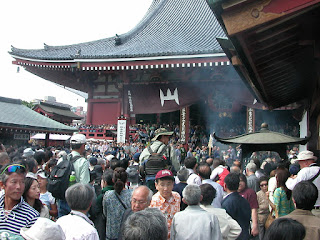This weekend me and Viktor, a friend from Germany currently visiting me, had the opportunity to experience yet another traditional Japanese festival. Every third weekend in May you can join the 三社祭 Sanja Matsuri in 浅草 Asakusa, Tokyo.
According to 欣也さん Kinya-san, our festival master, the Sanja Matsuri might well be Japan's largest Shinto festival with around 1.5 and 2 million visitors each year. Now this Shinto festival illustrates very well, how interwoven Shinto religion and Buddhism are in Japan. The topic of the festival is to honor the three founding father of the 金龍山浅草寺 Kinryuuzan Sensou-ji, Tokyo's oldest Buddhist temple. Yes a Buddhist temple, a Shinto festival to honor the founders of a Buddhist temple. It is common in Shinto to worship the souls of extraordinary men, like the 明治神宮 Meiji Shrine is dedicated to the soul of the great Meiji Emperor. And in this case the festival is thus dedicated to the worship of the three men who founded 浅草寺 Sensou-ji. But what was so extraordinary about them? Let's ask Wikipedia:
This Shinto festival dedicates an entire weekend to the kami (spirits) of three specific men. Of these men, it is believed that two fishermen - brothers named Hinokuma Hamanari and Hinokuma Takenari - found a statuette of the Bodhisattva Kannon (the Buddhist Goddess of Mercy) caught in a fishing-net in the Sumida River on May 17. The third man, a wealthy landlord named Hajino Nakatomo, heard about the discovery, approached the brothers and converted them to Buddhism. The three of them then devoted their lives to the Buddhist faith and consecrated the statue in a small temple. This temple, now known as the Sensō-ji, currently houses the Kannon statue and is the oldest temple in Tokyo.And how do they celebrate those spirits? Like most Shinto festivals, by carrying portable shrines through the city. This time the shrines are not 山車 Dashi, like in the 江戸天下祭り Edo Tenka Matsuri or gigantic penises like in the Kanamara Festival, but 御神輿 Omikoshi.
Omikoshi are much smaller than Dashi and there are no people on top. Instead they look a bit like the ark of the covenant and is carried in the same fashion. They are carried through the city with a lot of people for support buildings a long and cheerful parade.
Apart from the you can hear the usual cheerful screaming and enjoy yourself on countless festival stands 屋台 Yatai, which you can find all around the road selling food, sweets, ice cream and souvenirs. Something that is also necessary for Japanese festivals is of course music. Traditional music includes a series of drums accompanied by a flute. The music is really nice and makes you want to dance.


屋台 Yatai stands


there are lots of interesting shopping streets nearby


we had dinner close to the place, where the festival participants eat

I love Japanese festival music
Finally we were lucky, because one guy explained to us that after the Omikoshi parade has completely passed (there were 17 Omikoshi this year), the stage with the musicians will be cleared for a couple of 舞子 Maiko (apprentice 芸者 Geisha) performing traditional Geisha dances. The man said, usually such a performance performed by Geisha costs up to 25.000 Yen (~170 Euro), so we were quite lucky to see it for free.
After the festival we enjoyed the view from a bridge to the golden Asahi Beer building and watched countless jelly fish pass by in the river.


Bonus Pictures

Mika, Viktor, Kinya

Crazy guy with a custom made camera-fishing rod

this reminded me of the perverted men at the Tokyo Game Show

Crazy guy with a custom made camera-fishing rod

this reminded me of the perverted men at the Tokyo Game Show









No comments:
Post a Comment